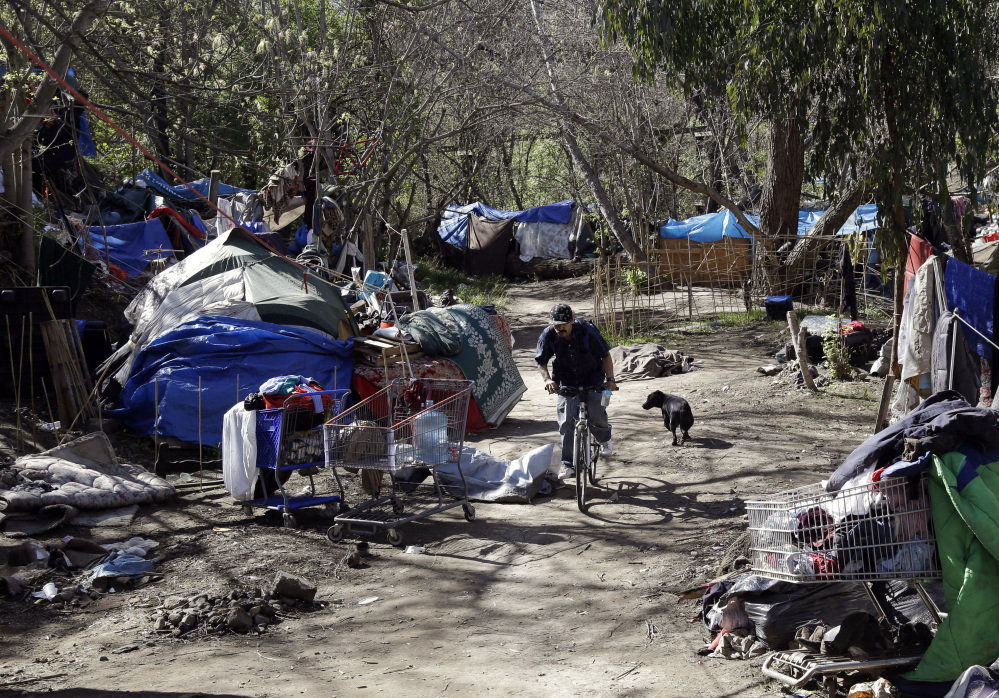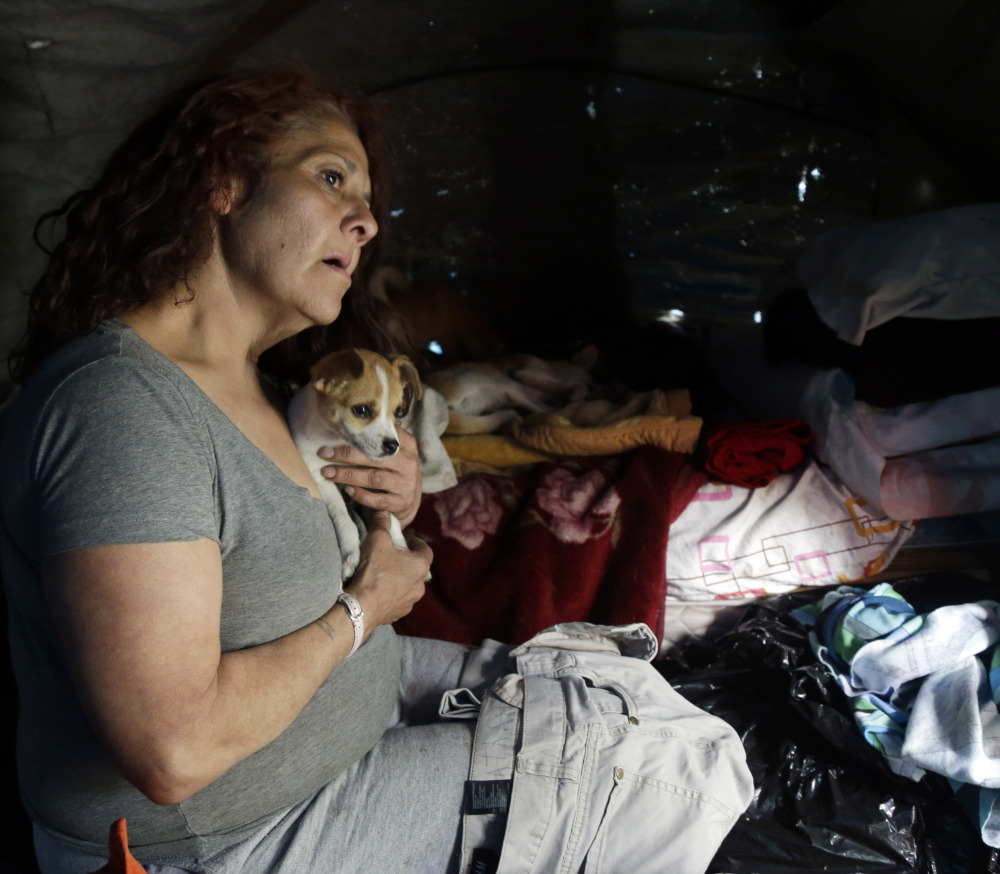SAN JOSE, Calif. — She’s a disheveled woman, upper teeth gone, heavy bags slung over her shoulders as she nervously urges on two friends shoving her overloaded shopping cart up a dirt slope. Maria Esther Salazar has been either homeless, in jail, or squatting at someone else’s house for 30 years.
But today, she’s getting her first apartment.
“Never in my wildest dreams did I ever imagine I’d get a house,” said Salazar. It was overwhelming. “I don’t know anyone there.”
In the Jungle – believed to be the nation’s largest homeless encampment – Salazar’s shelter is a gathering place where friends smoke pot, doze, swap stories, argue. Outside, they squat by her cooking fire frying pancakes or warming soup, handouts from Sunday church groups.
It’s easy to forget that the Silicon Valley’s entrepreneurs are making millions just miles away. Salazar and as many as 350 others live in tents, makeshift shacks, caves and tree houses along polluted Coyote Creek, spending their days and nights in various states of mental confusion and intoxication.
Salazar’s journey out began on a cool morning four months earlier in February, when she limped out of her fenced compound and waved a broken cane at a passing homeless support team making their weekly rounds.
“You’re supposed to be helping me,” she shouted, her voice gravelly beyond her 50 years.
When the social worker returned to her desk, she found that in a county with a seven-year, 20,000-person waiting list, Salazar had finally qualified for housing support: a new locally funded, $1,295 monthly subsidy aimed at ending chronic homelessness awaited her.
Now Maria Esther Salazar, a woman with a criminal record, two dogs, no phone and no identification had to find an apartment in one of the most expensive housing markets in the U.S., or the subsidy could disappear.
And she wasn’t sure she wanted to leave.
San Jose, the 10th largest city in the U.S., is at the heart of the Silicon Valley, home to Google, Apple, Facebook and many more. Job growth, income, and venture capital top the country.
But as tech has boomed after the recession, housing costs have soared.
An average home sells for $1 million, and two bedroom apartments rent for $2,000. The widening gap between the wealthiest and everyone else is palpable. Freeways back up with commuters who can’t afford to live near their work. Lines form at food pantries. With one of the largest unsheltered populations in the country, homeless people camp on corners, under bridges, along creeks.
Residents of the Jungle are well aware of the world that lies nearby. They call it “going up,” walking the dirt path up to busy Story Road, where minivans of families heading to Happy Hollow Park and Zoo across the street never notice the despair below.
In the Jungle, trails wind through trees and bushes, and there are neighborhoods like Little Saigon, where Vietnamese residents have dug large rooms into steep hillsides and squat by the creek to wash dishes and get water. “Stay Out” signs hanging on woven fences beneath a tree house built by an out-of-work carpenter. Their bathrooms are hand-dug holes or buckets. Mentally ill people burst from tents screaming and punching at unseen terrors. A man staggers by, bleeding from his ear after being hit with a shovel. A pregnant woman calls for help, her legs too swollen to get up. One morning, residents found a corpse in a tent.
“We’re like the scum of the earth,” said Salazar. “We’re like nobody.”
Salazar’s life fell apart at 11 when she was kidnapped and gang raped.
“Now I make a joke about it,” she says softly, smiling and crying at the same time. “I say I’m the president of the man-haters club.”
She’s been arrested dozens of times, convicted of 17 felonies, almost all drug related. She had four children but raised none. Her mother, or foster parents, took them in. One daughter is a nurse, another drives a school bus. She lost track of a son who was adopted while she was in jail. Another, Bobby, is in a small tent nearby strewn with towels, bike rims, a rotting plate of pasta.
She said she never took any welfare, perhaps not realizing her $347 a month in public assistance is just that.
Jennifer Loving, executive director of the nonprofit housing agency Destination: Home, is spearheading a new, concerted effort in San Jose to house people and keep them housed, not just out of compassion, but to save money. A homeless person can cost an estimated $60,000 a year, including trips to the emergency room and jail. The cost of housing someone can be just $16,000 a year.
In a 24-month pilot, they’ve housed 630 people, 76 percent of whom were still in their homes a year after moving in. One man, an amputee who had been sleeping in a creek bed, stopped making his near-daily trips to the emergency room.
New York, Los Angeles and Atlanta have seen similar success with Housing First initiatives.
On a clear June morning, Salazar clambered into her social worker’s car for a momentous journey. Ten minutes later, but a world away, they pulled into a clean, two-story apartment complex. Salazar checked out the clubhouse, the barbeque areas, a fitness center. Her dog rolled on the lawn. And then a property manager handed her the keys.
“Everything is so white! It’s my favorite color!” she said, bursting into her new home, a carpeted, corner apartment.
Two weeks later, she was settling in. She gave her rambling, trashy, makeshift tent to her son Bobby.
Back at the Jungle, he moved in.
Send questions/comments to the editors.




Success. Please wait for the page to reload. If the page does not reload within 5 seconds, please refresh the page.
Enter your email and password to access comments.
Hi, to comment on stories you must . This profile is in addition to your subscription and website login.
Already have a commenting profile? .
Invalid username/password.
Please check your email to confirm and complete your registration.
Only subscribers are eligible to post comments. Please subscribe or login first for digital access. Here’s why.
Use the form below to reset your password. When you've submitted your account email, we will send an email with a reset code.